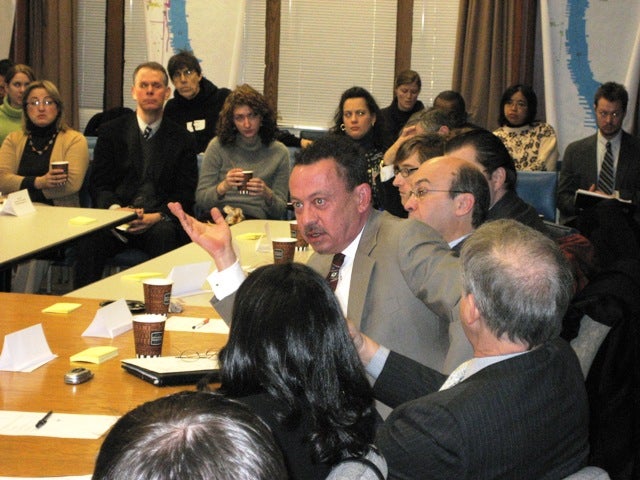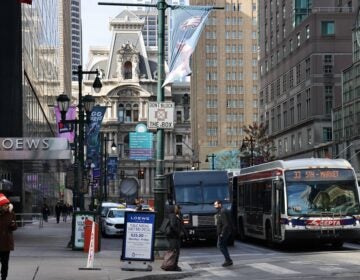Updated: Advisory Group meets

Feb. 5
By Matt Blanchard
For PlanPhilly
The Central Delaware Riverfront Advisory Group discussed “framing concepts” for the waterfront at its monthly meeting on Monday, seven purely conceptual visions of what might be possible in the seven-mile planning area, from an “emerald necklace” of parks to a “living riverfront” of new neighborhoods along the water’s edge.
These concepts will be used to focus leading design professionals, citizens and public intellectuals as they integrate civic design principles into the beginning of a vision for the Central Delaware March 1-3.
The seven concepts are discussed below.
Casino Debate
But first, the 45-member group continued to debate the body’s position on the casino question: Should PennPraxis develop not one, but two plans for the riverfront, one assuming that the two planned casinos are built, and another assuming that the casinos are somehow stopped?
The concept of creating “No-Build” and “Build” plans was originally raised by Center City District director Paul Levy during last week’s Steering Committee meeting. Monday, Levy expressed concern that resident opposition to the state-imposed casinos was draining energy and participation from the larger planning effort.
“People aren’t willing to engage in the planning process and negotiate with the casinos because, quite frankly, they see that as dealing with the devil,” Levy said. He hopes that by allowing a No-Build option, the urgently-needed master plan for the river will not be hindered by the casino controversy.
The strongest support for a No-Build plan was articulated by Jeremy Beaudry of the Fishtown Neighbors Association, who said he was “frankly appalled” that the Street administration was allowing the state to dictate outcomes on the riverfront that run counter to loudly-expressed preferences of the people who live there.
“I thought this was about civic engagement and representing the people of Philadelphia.”
Other voices, however, urged opponents to make a distinction: If one opposes the casinos, is the Riverfront Advisory Group the right forum in which to fight them?
Representing the City Solicitor’s Office, Kevin Greenberg reminded the body that only the state can change the casino outcome, and it is to the state that citizens can direct their anti-casino efforts.
“The City isn’t saying you shouldn’t sue,” Greenberg said. “The state has made its decision, and unless that changes, we’re stuck. That doesn’t mean you can’t try to lobby the legislature or fight outside [this forum].”
Rina Cutler, head of PennDOT’s District 6, was unequivocally opposed to considering a no-build option.
“For me, the exercise of planning what happens on the Delaware cannot be about the casinos. The chances of prevailing in that fight are slim,” she said. “If this group decides that’s the direction this group will go, I will probably take a step back from it.”
Since the Advisory Group does not have a legislative function, a decision on the issue will not be reached by vote but rather by gradual consensus. The ultimate decision of what plan to undertake lies in part with PennPraxis, whose director Harris Steinberg appeared inclined not to undertake a No-Build plan.
“These are two sites within seven miles,” Steinberg said. “Regardless of what happens with the casinos, planners have a lot of work to accomplish in a short time, as development pressure intensifies along the river.
“It is incumbent on us to get ahead on this because the train is moving very, very quickly,” Steinberg said. “This is not the casino/no-casino forum. If we get stuck there, I think we’re going to lose the moment.”
Framing Concepts
Key aspects of some of the nation’s best waterfront plans, presented at Saturday’s Best Practices Sessions, have been abstracted into seven “framing concepts.”
These seven concepts, explained at the meeting by Nando Micale of design consultant Wallace, Roberts and Todd, and City Planning Director Janice Woodcock, are not actual plans or proposals. Rather, they are intellectual handles by which to grasp the basic options available for Philadelphia’s waterfront. They may be emphasized, de-emphasized, or happen at different parts along the seven miles.
1) The Emerald Necklace – creating a network of green spaces linked by pathways.
2) The Port that Built the City and the State – attending to the expansion and dredging needs of Philadelphia’s port.
3) The Beautiful Boulevard – making Delaware Avenue into a world-class avenue, our own answer to San Francisco’s Embarcadero.
4) 1681 Revisited – restoring portions of the waterfront to their condition at the founding of the city. This may include re-opening several natural streams covered over by streets in the 19th century.
5) Entertainment Paradise – creating a district of clubs, casinos and other tourist attractions.
6) A Living Waterfront – making neighborhoods along the waterfront by extending small-scale neighborhood fabric of the river wards right to the river’s edge.
7) Two Cities, One River – focusing on opportunities to connect with Camden’s revitalized waterfront.
The next meeting of the Central Delaware Riverfront Advisory Group will be held March 5.
WHYY is your source for fact-based, in-depth journalism and information. As a nonprofit organization, we rely on financial support from readers like you. Please give today.






